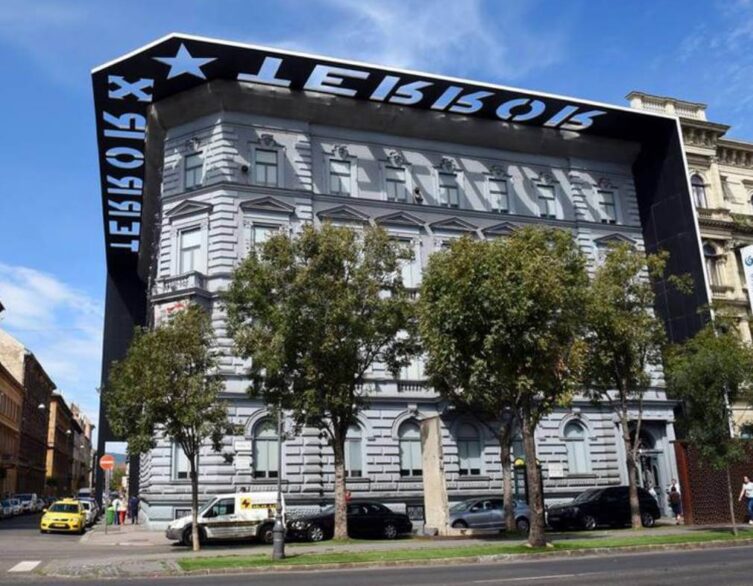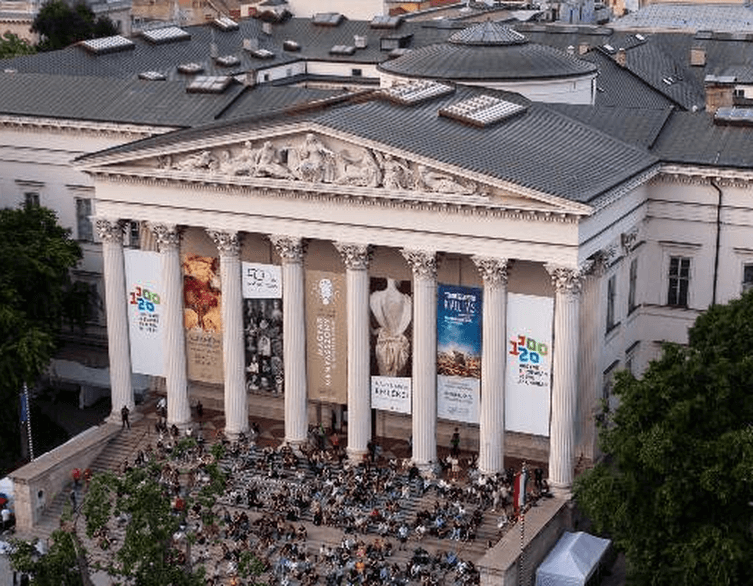The House of Terror Museum: The Memento For The Future Generations

The House of Terror Museum in Budapest, Hungary is a powerful and moving testament to the dark period of fascist and communist rule in the country during the 20th century. Located at 60 Andrássy Avenue, the building itself served as the headquarters of the fascist Arrow Cross Party and later the communist secret police (ÁVH). Today, it stands as a memorial to the victims of these oppressive regimes, educating visitors about this painful chapter in Hungary’s history.
Historical Significance
The House of Terror Museum in Budapest serves as a powerful reminder of Hungary’s dark history under fascist and communist regimes in the 20th century. Located at 60 Andrássy Avenue, the building itself was once the headquarters of the Arrow Cross Party, Hungary’s fascist organization, and later the communist secret police (ÁVH). The museum’s exhibits and memorials offer a chilling glimpse into the atrocities committed within its walls and the suffering endured by the Hungarian people during these oppressive eras.
For foreign tourists visiting Hungary, the House of Terror provides a crucial context for understanding the country’s complex past and its ongoing struggle for freedom and democracy. The museum’s permanent exhibition chronicles the Nazi occupation of Hungary, the reign of terror under the Arrow Cross Party, and the subsequent Soviet occupation and communist dictatorship. Visitors can explore the building’s former torture chambers, interrogation rooms, and prison cells, which stand as stark reminders of the inhumane treatment inflicted upon countless victims.
The museum also pays tribute to the brave individuals who resisted these oppressive regimes, including those who participated in the 1956 Hungarian Revolution against Soviet rule. By showcasing the stories of these heroes and the sacrifices they made, the House of Terror inspires visitors to reflect on the importance of defending human rights and fighting against tyranny.
Beyond its role as a memorial, the House of Terror serves as an educational institution, providing a platform for dialogue and reflection on the dangers of totalitarianism and the importance of preserving democratic values. The museum’s exhibits and artifacts, including photographs, documents, and personal belongings of victims and perpetrators, offer a tangible connection to this dark chapter in Hungary’s history, ensuring that the lessons of the past are not forgotten.
For Hungarians, the House of Terror is a symbol of national resilience and a testament to the country’s determination to confront its painful past and build a better future. By preserving the memory of those who suffered and died under these oppressive regimes, the museum plays a vital role in the ongoing process of national healing and reconciliation.
In conclusion, the House of Terror Museum in Budapest stands as a powerful reminder of Hungary’s turbulent history and a tribute to the victims of fascist and communist terror. For foreign tourists, it offers a deeper understanding of the country’s struggles and the importance of defending freedom and human rights. As a site of remembrance and education, the House of Terror ensures that the lessons of Hungary’s past continue to inform and inspire future generations.
Provided Services
The House of Terror Museum in Budapest offers a range of services to enhance the experience of foreign tourists visiting Hungary. Located at Andrássy Avenue 60, the museum is dedicated to the memory of those detained, interrogated, tortured, or killed in the building during the fascist and communist regimes of the 20th century.
Permanent Exhibition: The museum’s permanent exhibition is spread across three floors, with each level focusing on different aspects of Hungary’s totalitarian past. Visitors can explore the exhibits related to the Nazi occupation, the Soviet-backed communist regime, and the resistance movements against these oppressive forces. The exhibition includes a variety of multimedia displays, historical artifacts, and informative materials in both Hungarian and English.
Audio Guides: To cater to international visitors, the House of Terror Museum provides audio guides in several languages, including English, German, Spanish, Russian, French, and Italian. These audio guides offer detailed explanations of the exhibits and help visitors better understand the historical context of the events portrayed in the museum.
Guided Tours: For those who prefer a more personalized experience, the museum offers guided tours in English. These tours, which must be booked in advance, are available for groups of 10 to 30 people. The knowledgeable guides provide in-depth insights into the exhibits and answer any questions visitors may have about Hungary’s turbulent past.
Bookstore: The museum’s bookstore is accessible without an admission fee and offers a wide selection of books, publications, and souvenirs related to the museum’s theme. Visitors can find materials in various languages, allowing them to further explore the topics covered in the exhibition.
Accessibility: The House of Terror Museum is easily accessible by public transportation, with the Millennium Underground (M1) and trams 4 and 6 stopping nearby. The museum is located just a short walk from Vörösmarty utca underground station and Oktogon tram stop.
Opening Hours and Admission: The museum is open every day except Monday, from 10:00 AM to 6:00 PM, with the cash desk closing at 5:30 PM. Admission prices vary, with discounts available for students, seniors, and families. It is important to note that tickets can only be purchased at the museum, as there is no online payment option. Admission tickets can be purchased at the museum. Guided tours in English are available for an additional fee and can be booked in advance.
Reduced Admission: Reduced admission is available for visitors aged 6-25 and 62-70 who are citizens of the European Economic Area (EEA). Please present a valid document (e.g., passport, identity card, or student ID) to avail of the reduced price.
Free Admission: Admission is free for teachers (EEA citizens) with a valid teacher’s ID and visitors aged 70 or older (EEA citizens). Please present the necessary documents at the ticket office.
Allow yourself ample time to explore the exhibits. Most visitors spend at least 2-3 hours in the museum. The building and exhibits provide a solemn and informative look at a dark period in Hungary’s 20th century history under fascist and communist regimes.
Best deals of Budapest
By providing these services, the House of Terror Museum ensures that foreign tourists can fully engage with the exhibits and gain a deeper understanding of Hungary’s past struggles under totalitarian regimes. The museum’s commitment to offering materials and tours in multiple languages demonstrates its dedication to educating and informing visitors from around the world.
House Rules
To ensure a meaningful and respectful experience for all visitors, we kindly ask you to adhere to the following house rules during your visit:
- Photography and Video Recording: Visitors are not allowed to take photographs or record videos inside the exhibition areas, except for the tank on the ground floor. Please refrain from using cameras or mobile devices for this purpose.
- Silence and Respect: The House of Terror Museum is a memorial to the victims of the fascist and communist regimes in Hungary. Please maintain silence and show respect while exploring the exhibitions. Avoid talking loudly or using mobile phones that may disturb other visitors.
- Prohibited Items: For safety and security reasons, it is prohibited to bring vehicles (including bicycles and scooters), live animals (except assistance dogs), knives, or any objects that may endanger the exhibits or visitors into the museum.
- Dress Code: Please dress appropriately when visiting the House of Terror Museum. Access will be denied to visitors wearing inadequate clothing (e.g., swimwear or being barefoot).
- Food and Drinks: Eating is not allowed inside the exhibition areas. You may bring drinks in a tightly closed bottle.
- Closing Time: Please be mindful of the museum’s closing time. Visitors are requested to leave the exhibition area when instructed by the staff and retrieve their belongings from the cloakroom at least 10 minutes before closing.
- Children under the age of 14 must be accompanied by an adult, and parents or guardians are responsible for their supervision and behavior. The museum reserves the right to refuse admission or ask visitors to leave if they do not comply with the house rules or if their behavior is disruptive or inappropriate.
We appreciate your cooperation in following these house rules to ensure a safe and enriching experience for everyone. If you have any questions or concerns, please do not hesitate to approach our staff members.
Getting There
The House of Terror Museum is located at Andrássy Avenue 60 in Budapest, Hungary. It is easily accessible by public transportation.
Metro: The museum is just a short walk from the Vörösmarty utca station on the M1 (yellow) metro line. Take the metro to this stop and exit the station. The museum will be about a 3-minute walk down Andrássy Avenue.
Tram: Tram lines 4 and 6 both have stops near the museum. Get off at the Oktogon stop. From there, walk down Andrássy Avenue for about 5 minutes until you reach the museum at number 60.
Bus: Several bus lines have stops in the vicinity of the museum. Buses 105 and 178 stop at Oktogon, just a short walk from the museum.
On Foot or by Bike: If you are staying in central Budapest, the museum is within walking distance of many hotels. It is located about halfway between Heroes’ Square and the Opera House on Andrássy Avenue. The avenue itself is a UNESCO World Heritage Site lined with beautiful neo-renaissance mansions. Walking or biking allows you to take in this impressive architecture.
Parking: If you are driving, there is limited street parking available on the side streets off Andrássy Avenue. Be sure to pay attention to parking signs and fees.
Nearby Attractions
Andrássy Avenue – This iconic boulevard where the museum is located is a UNESCO World Heritage Site lined with beautiful neo-renaissance mansions, high-end boutiques, and cafes. Take a stroll down the tree-lined avenue to admire the architecture.
Heroes’ Square (Hősök tere) – Located at the end of Andrássy Avenue, about a 10-15 minute walk from the museum. This major square features the iconic Millennium Memorial with statues of the leaders of the seven tribes that founded Hungary in the 9th century. The Museum of Fine Arts and Palace of Art are also on this square.
City Park (Városliget) – Budapest’s main park just beyond Heroes’ Square. Home to the Széchenyi Thermal Bath, Vajdahunyad Castle, the Budapest Zoo, and a lake that’s popular for ice skating in the winter.
Hungarian State Opera House – Located on Andrássy Avenue, just a 5-minute walk from the museum. If you have time, try to see a performance in this opulent neo-Renaissance opera house. Tours are also available.
Liszt Ferenc Academy of Music – This beautiful Art Nouveau concert hall is located just off Andrássy Avenue, about a 10-minute walk from the museum. Catch a concert if you can in the ornate auditorium.
Minipolisz: an interactive family center located in the heart of Budapest, designed to offer children between the ages of 3 and 12 a unique “grown-up experience”. This 1000 m2 mini-city provides a realistic environment tailored to children’s sizes, where they can explore and engage in activities that are typically reserved for adults.
Gozsdu Udvar – A passage of interconnected courtyards between Király utca and Dob utca with bars, restaurants, and shops. Popular nightlife spot about a 15-20 minute walk from the museum.
Summary
The House of Terror Museum in Budapest is a must-visit destination for anyone interested in understanding the impact of fascist and communist rule on Hungary and its people. By preserving the memory of those who suffered and died under these oppressive regimes, the museum serves as a powerful reminder of the importance of vigilance in defending human rights and democracy.
Through its thought-provoking exhibitions, informative guided tours, and engaging public programs, the House of Terror Museum offers visitors a comprehensive and emotionally resonant exploration of one of the darkest chapters in Hungary’s history. It is an essential stop for any traveler seeking to gain a deeper understanding of the country’s past and its ongoing efforts to build a brighter future.
Related news
Related events
Related attractions























